We've had a cold winter here, and we've had few opportunities to open up our hives to check on the bees.
It depends on which expert you are asking, but you should only open up a hive if its above about 45F. The rule I've read is if you have to wear a heavy jacket, you should not be opening up a hive.
Why open up a hive? Many hives perish in late winter or early spring when they may have run out of food. You want to get a quick peek to if there is food in the comb and if they bees are alive.
After reading and talking to our bee mentors, we decided to slip some fondant into our hives, as well as new grease patties. Fondant can be bought at a bakery supply or some craft stores, or you can make it yourself. There is a good discussion of making fondant on the Bee Source forum here. Pressed for time, we picked up some fondant at a craft store.
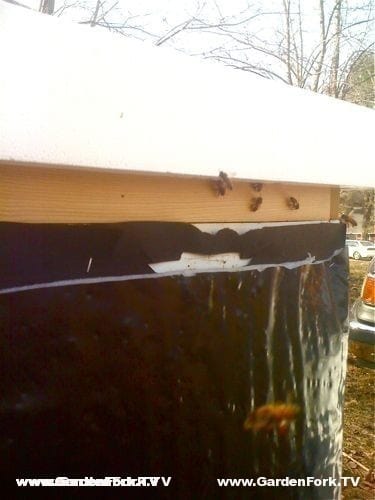
Bees entering thru inner cover gap
We finally had a day where the weather was in the 50s F, we opened up our hive at Maple Knoll Farm. We found a lot of dead bees on the bottom board, and we cleaned these out. The bees were out, already bringing in pollen ( we think from maple trees ), and they were entering the hive through the small gap in the inner cover.
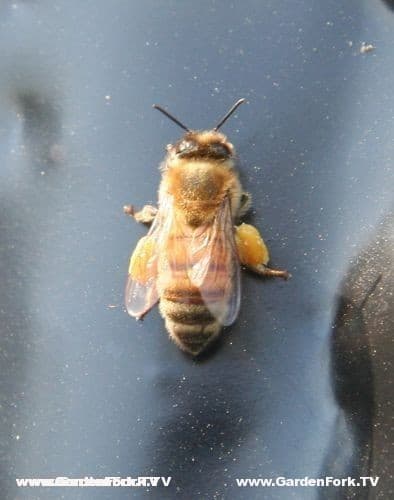
Honey bee with pollen in late winter
To put the fondant on top of the frames, I built a simple spacer to allow the fondant to sit on top of the top super. We did a quick check of the frames in this top super - do not pull out the frames, just look down into them - and we found ample food in the comb. We decided to add the fondant and a grease patty just to be safe.
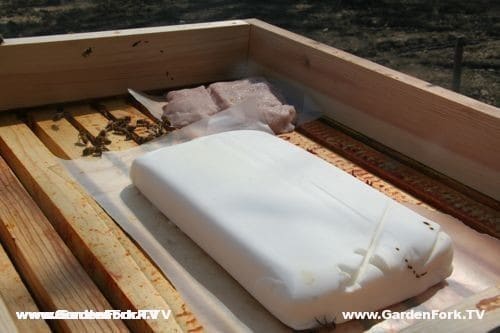
Spacer or shim allows for block of fondant and grease patty
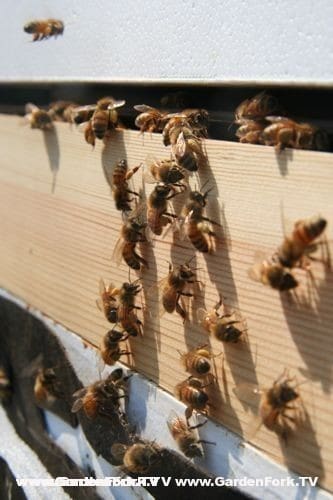
Honeybees brining in a yellow pollen in late winter
We watched the bees, and despite us cleaning out the dead bees from the bottom board, they continued to use the inner cover entrance.
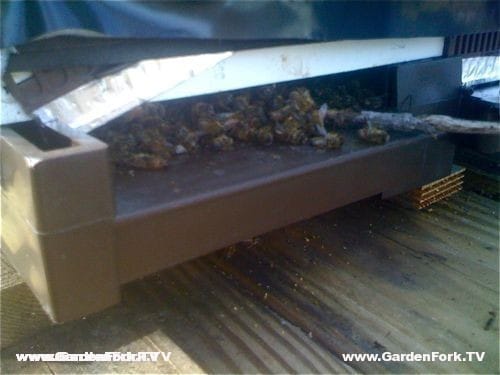
Dead bees pile up at the bottom of the hive during winter
A few days later we decided, since it had been so warm, to put a sugar feeder on top of the hive, with a 1:1 sugar syrup ( 1 lb of sugar to each 1 pint of water ). We pulled off the polystyrene and inner covers to find they bees had barely touched the fondant. They had been using the grease patty.
We left the fondant and spacer on, then put on the sugar feeder. We saw the feeder had warped, and there were gaps along the edge that mates with the hive body. The honeybees were trying to get into the hive between the feeder and the spacer. ( When adding a sugar feeder to the top of the hive, you do not use the inner cover, as it would allow bees to get into the syrup reservoir and drown. )
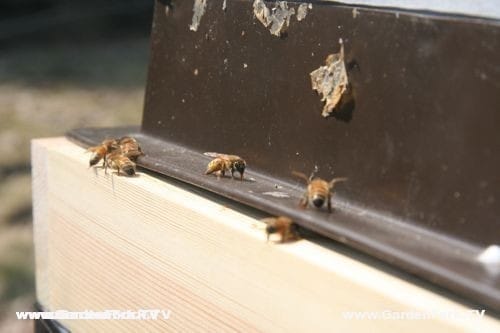
Bees trying to enter hive under warped feeder
Remembering in some of my beekeeping books, people do drill entrances into upper hive bodies, i opted to drill a hole in the spacer to allow the bees to enter the top of the hive. I also screwed the warped edges of the feeder into the spacer.

With no inner cover on the hive, I made an upper entrance.
All the time we were at the hive, the bees were bringing in pollen, which i was suprised by. I'm thinking it was probably maple tree pollen and some other early flowering plant that was a nice yellow color, perhaps pussy willows.
Each hive got a gallon of sugar syrup, as well as leaving the fondant on the hive. This week I will probably remove the fondant and top up the sugar syrup.
What have your experiences been with late winter beekeeping? Please let us know below:

denise
Eric, you seem to be doing a great job with your bees- whoever you took classes from prepared you well. I have been keeping bees in VA for years, but have lost my bees this year (1st time they have not overwintered successfully for me) So new nucs in early april- Our season starts much earlier than yours! Good luck, hopefully you'll get some honey this year. Harvest spring and fall (if you have a fall flow) you will find they taste totally different. I like the fall honey better- much richer down here. I have found my bees do much better if I leave their honey on the hive rather than feeding them syrup for winter.
Eric Gunnar Rochow
thx! Jim Fischer, the scientist behind Fischer's Bee Quick, taught our 8 session class. he's great. and he was one of the people who helped legalize beekeeping in NYC, along with Just Food NYC.
howard
GREAT job Eric...Thank You!
Does it cause any harm to the hive to wrap the hive with black plastic..ie: cutting off air flow...creating condensation and thereby causing bees to freeze?
Howard
Eric Gunnar Rochow
the black plastic has a foam liner inside, and so it can breathe. and we have some videos about eliminating condensation in the hive with our insulated inner covers, which work great. thanks, eric.